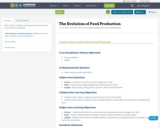
ELA, History, and Math unit that links food production, eating choices, and health.
- Subject:
- English Language Arts
- Mathematics
- Social Science
- Material Type:
- Unit of Study
- Date Added:
- 03/28/2015

ELA, History, and Math unit that links food production, eating choices, and health.

This resource is a video abstract of a research paper created by Research Square on behalf of its authors. It provides a synopsis that's easy to understand, and can be used to introduce the topics it covers to students, researchers, and the general public. The video's transcript is also provided in full, with a portion provided below for preview:
"Managing wastewater is a major logistical puzzle that impacts the environment, the climate, and public health. While metropolitan wastewater typically undergoes complex processing and sanitation, rural livestock wastewater is often simply composted for fertilizer, but composting can release harmful contaminants like ammonia, CO₂, and methane. One way to still capture the nutrients with fewer harmful byproducts is by cultivating microalgae, which actually absorb CO₂ via photosynthesis rather than producing it. But how do microalgae impact pathogens? A recent pilot study using raw piggery wastewater found that microalgae cultivation dramatically reduced the pathogen load while also triggering a dramatic shift in the overall bacterial community composition. Further investigation using the most abundant pathogen, Oligella, found that the microalgae weren’t impacting Oligella directly. Rather, microalgae cultivation reduced Oligella abundance through a network of other bacterial species..."
The rest of the transcript, along with a link to the research itself, is available on the resource itself.
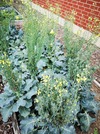
Did you know that broccoli, cauliflower, and artichokes make a lovely bouquet of flowers? The students will examine the functions of flowers and determine that some flowers are edible, even tasty! This K-2nd grade lesson includes background information, vocabulary words, step-by-step procedures, links to other lessons about plants, and plant lifecycle illustrations.
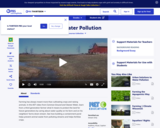
In this video from Common Ground and Cleaner Water, Tribby Vice, a Kentucky farmer, talks about the changes he has made on his farm to protect the water quality of the stream running through his property and the watershed in which he lives.
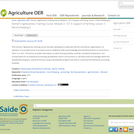
This Farmers' Agribusiness training course has been developed to help both farmers and farmer organisations. Its intention is to provide access to provide access to additional skills and knowledge that will allow farmers to move from a 'farm' to a 'firm'. This lesson provides information on what farming activities could be considered 'Enterprises' and incorporated into an Enterprise Accounting spreadsheet, how to use functions to calculate totals and averages within the spreadsheet program, customise formula using a spreadsheet program and how to customise the Enterprise accounting template.

Financial Statements & Present Value Models
Short Description:
This book is for those whose financial management focus is on small businesses. For you, we adapt the traditional financial management themes emphasized in corporate financial management courses to meet the needs of small businesses.
Long Description:
This book is for those whose financial management focus is on small businesses. For you, we adapt the traditional financial management themes emphasized in corporate financial management courses to meet the needs of small businesses.
Many financial managers of small businesses come from farms or agribusinesses. Others are interested in working for or starting businesses in the food or retail sectors. In most cases, these businesses aren’t organized as C-corporations impacting things like taxes, depreciation, and legal requirements around compiling and reporting financial data. They are rarely publicly traded which creates unique constraints to raising debt and equity capital and calculating required risk-adjusted returns.
These financial managers are interested in solving specific problems they face in family or small businesses. They want to know how to apply the tools they are learning—coordinated financial statement analysis, present value analysis, management of cash flow, measuring their opportunity costs, etc.—to the problems they face at home. As we started to work on the actual problems faced by these managers, it quickly became clear that corporate finance tools don’t exactly fit the small businesses they come from. Further, in attempting to tackle the problems they bring, we learned that finding and/or constructing the data needed for financial management is another skill set often overlooked and in need of development. In the end, after investing a lot of time, we found that—without adaptation—corporate finance theory as traditionally taught doesn’t meet the knowledge needs and application skills of financial managers of small businesses. We wrote this book to be a catalyst that enables students and managers of small businesses to learn the tools and skill sets that will help them make sound financial management decisions.
Word Count: 179566
ISBN: 978-1-62610-114-2
(Note: This resource's metadata has been created automatically by reformatting and/or combining the information that the author initially provided as part of a bulk import process.)

Explains the history of the neolithic era and the origins of the first agricultural revolution, and how that contributed to agriculture today.

Students will observe the physical characteristics of flowers and explore the principles of pollination with this 3rd-5th grade lesson. From Bee Dancing to flower direction, this lesson will engage young minds and explore the miracle of flower reproduction with some amazing little pollinators!
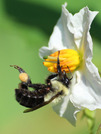
Students will observe the physical characteristics of flowers and explore the principles of pollination with this 3rd-5th grade lesson. From Bee Dancing to flower direction, this lesson will engage young minds and explore the miracle of flower reproduction with some amazing little pollinators! Attribution for image used: "Balancing Act" by LadyDragonflyCC - >;< is licensed under CC BY 2.0.

This course explores connections between what we eat and who we are through cross-cultural study of how personal and collective identities, social relations, and economic inequalities are formed and maintained via practices of food production, preparation, and consumption. Discussions are organized around critical discussion of what makes “good” food good (tasty, healthy, authentic, ethical, etc.), and draw on anthropological studies as well as recent writing and films on the politics of food and agriculture. A primary goal of the course is to provide students with conceptual tools to understand and evaluate food systems at local and global levels. Instruction and practice in written and oral communication is provided.
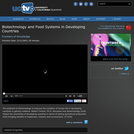
The potential of biotechnology to improve the condition of human life in developing countries is gaining credence. Robert Timmer, Ph.D. discusses how biotechnology could impact the economies of developing countries in terms of raising agricultural production while bringing benefits to healthcare, industry and environment. (28 minutes)

This resource is a video abstract of a research paper created by Research Square on behalf of its authors. It provides a synopsis that's easy to understand, and can be used to introduce the topics it covers to students, researchers, and the general public. The video's transcript is also provided in full, with a portion provided below for preview:
"Animal health is of utmost importance in the production of milk, meat, and other animal products. Although vitamin supplements can help ensure livestock remain as healthy as possible, they are often expensive, driving up the cost of production. To help reduce these costs, a team of researchers set out to better understand how the essential vitamins B and K₂ are produced by microbes in the gastrointestinal tracts of ruminants, which are animals with complex digestive tracts composed of multiple distinct compartments to help them break down their plant-based diets. The team used genetic data from previous studies to identify 1,135,807 genes and 2366 full genomes involved in B or K₂ vitamin biosynthesis in the gastrointestinal tracts of seven ruminant species. They also found that most of this biosynthesis took place in the stomach compartments rather than other regions and that a high-grain diet enhanced most vitamin biosynthesis but inhibited cobalamin synthesis..."
The rest of the transcript, along with a link to the research itself, is available on the resource itself.
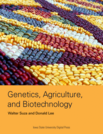
Short Description:
This textbook provides an introduction to plant genetics and biotechnology for the advancement of agriculture. A clear and structured introduction to the topic for learners new to the field of genetics, the book includes: an introduction to the life cycle of the cell, DNA and how it relates to genes and chromosomes, DNA analysis, recombinant DNA, biotechnology, and transmission genetics.
Long Description:
This textbook provides an introduction to plant genetics and biotechnology for the advancement of agriculture. A clear and structured introduction to the topic for learners new to the field of genetics, the book includes: an introduction to the life cycle of the cell, DNA and how it relates to genes and chromosomes, DNA analysis, recombinant DNA, biotechnology, and transmission genetics.
Word Count: 45195
(Note: This resource's metadata has been created automatically by reformatting and/or combining the information that the author initially provided as part of a bulk import process.)

In a 21st century globally-competitive society, agriculture is rapidly progressing and incorporating more innovative STEM practices (Science, Technology, Engineering and Mathematics). A number of agriculture advances incorporate genetics, which is an important unit in seventh-grade science. The lesson exposes students to a real-life application of genetics and technology to improve agriculture production and profit. The lesson specifically addresses bioengineering, biotechnology and selective breeding. Students use the technique of selective breeding in a class competition to make the best and most profitable grapes to sell to local industries. In doing so, they will learn about progressive agriculture science and technology, while covering the seventh-grade science genetics standards.

For the first time in history, the global demand for freshwater is overtaking its supply in many parts of the world. The U.N. predicts that by 2025, more than half of the countries in the world will be experiencing water stress or outright shortages. Lack of water can cause disease, food shortages, starvation, migrations, political conflict, and even lead to war. Models of cooperation, both historic and contemporary, show the way forward. The first half of the course details the multiple facets of the water crisis. Topics include water systems, water transfers, dams, pollution, climate change, scarcity, water conflict/cooperation, food security, and agriculture. The second half of the course describes innovative solutions: Adaptive technologies and adaptation through policy, planning, management, economic tools, and finally, human behaviors required to preserve this precious and imperiled resource. Several field trips to water/wastewater/biosolids reuse and water-energy sites will help us to better comprehend both local and international challenges and solutions.
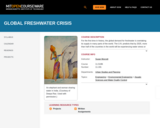
For the first time in history, the global demand for freshwater is overtaking its supply in many parts of the world. The U.N. predicts that by 2025, more than half of the countries in the world will be experiencing water stress or outright shortages. Lack of water can cause disease, food shortages, starvation, migrations, political conflict, and even lead to war. Models of cooperation, both historic and contemporary, show the way forward. The first half of the course details the multiple facets of the water crisis. Topics include water systems, water transfers, dams, pollution, climate change, scarcity, water conflict/cooperation, food security, and agriculture. The second half of the course describes innovative solutions: Adaptive technologies and adaptation through policy, planning, management, economic tools, and finally, human behaviors required to preserve this precious and imperiled resource. Several field trips to water/wastewater/biosolids reuse and water-energy sites will help us to better comprehend both local and international challenges and solutions.
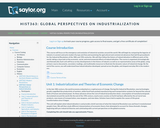
This course will focus on the emergence and evolution of industrial societies around the world. The student will begin by comparing the legacies of industry in ancient and early modern Europe and Asia and examining the agricultural and commercial advances that laid the groundwork for the Industrial Revolution. The student will then follow the history of industrialization in different parts of the world, taking a close look at the economic, social, and environmental effects of industrialization. This course ultimately examines how industrialization developed, spread across the globe, and shaped everyday life in the modern era. Upon successful completion of this course, students will be able to: identify key ideas and events in the history of industrialization; identify connections between the development of capitalism and the development of modern industry; use analytical tools to evaluate the factors contributing to industrial change in different societies; identify the consequences of industrialization in the 19th and 20th centuries in different societies; critique historical interpretations of the causes and effects of industrialization; and analyze and interpret primary source documents describing the process of industrialization and life in industrial societies. (History 363)

This course explores the values (aesthetic, moral, cultural, religious, prudential, political) expressed in the choices of food people eat. Analyzes the decisions individuals make about what to eat, how society should manage food production and consumption collectively, and how reflection on food choices might help resolve conflicts between different values.
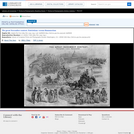
The strongly racist character of the Democratic presidential campaign of 1868 is displayed full-blown in this elaborate attack on Reconstruction and Republican support of Negro rights. Horses with the heads of Democratic candidate Horatio Seymour and running mate Francis P. Blair, Jr., pull a fine, ornate carriage in a race with a rude wagon drawn by asses with the heads of Republican candidates Ulysses S. Grant and Schuyler Colfax. The Democratic carriage pulls ahead in the race, heading toward a cheering crowd and a series of floral arches held by young maidens. The U.S. Capitol is visible beyond. In the carriage are four allegorical figures: Liberty, holding the Constitution and a banner which reads "Our Glorious Union Dü_üąistinct, like the Billows, One, Like the Sea' This is a White Man's Government!"; Navigation, holding a miniature ship; Agriculture, holding sheaves of wheat and a scythe; and Labor, represented by a bearded man with a hammer and flywheel. In contrast to the Democratic vehicle, the Republican wagon has stalled before a pile of rocks and a cemetery strewn with bones representing "100,000,000 White Lives, the Price of Nigger Freedom!" Its wheels are blocked by a large stone "Killing Taxation" and a skeleton. Other stones represent "Ruined Commerce," "$30,000,000 stolen from the Treasury," and "Negro Supremacy." In the wagon are the grim reaper, Pennsylvania representative and abolitionist Thaddeus Stevens, an unidentified man, a black woman, and an idle black man. Stevens: "Colfax pulls like the d----l but old tangleleg [i.e., Grant] aint worth a d----n! Push at the tailboard, Ben!" Massachusetts representative and former Civil War general Benjamin F. Butler, pushing the wagon from the rear, replies, "I am pushing, Thad! but we are stuck. Seymour is a mile ahead now." Silver spoons protrude from Butler's pocket. (For the origins of Butler's nickname "Silver Spoons," see "The Radical Party on a Heavy Grade," no. 1868-14.) The black woman reassures Stevens, "Don't worry you'sef, honey, or you'll peg out afore we get de paeket for Seymour's in de White House and we's good for Salt River [colloquialism for political disaster]." The black man asks, "War's dis wagon gwine wid dis member ob Congress. I'd jes like to know?" The unidentified man remarks, "The Democracy would not take me so I thought I'd come back & stick by you Uncle Thad, and we'll all go to H-ll together!" Death announces, "My friends 1,000,000 slaughtered soldiers block the wheels--you fooled them, and they now impede your progress!" At bottom right a group of bummers, a term referring to party hangers-on, carpetbaggers, and other disreputable characters, stand in line to buy tickets to Salt River. At left New York "Tribune" editor Horace Greeley invites abolitionist preacher Henry Ward Beecher to play the thimblerig. Nearby a black couple in rags express their desire to return to their former master. At top right, next to the U.S. Capitol, a group of black youths in striped outfits dance and tumble about. In the lower right margin are prices and information regarding ordering copies of the print by mail. "Price 25 cents mailed. 5 for $1.00. 60 for $10.00, 100 for $16.00. Nothing sent C.O.D. Express charges paid by Parties ordering. Address: Bromley & Co. Box 4265. New York City.|Entered . . . l868 by Bromley & Co. . . . New York|Title appears as it is written on the item.|Lorant, p. 303.|Weitenkampf, p. 157.|Forms part of: American cartoon print filing series (Library of Congress)|Published in: American political prints, 1766-1876 / Bernard F. Reilly. Boston : G.K. Hall, 1991, entry 1868-15.

The Green Design Challenge is to brainstorm, prototype and present a design idea for a social entrepreneurship project focusing on green design that meets the design principles. Photo examples from ISKME's Teacher Innovation Workshop are included.